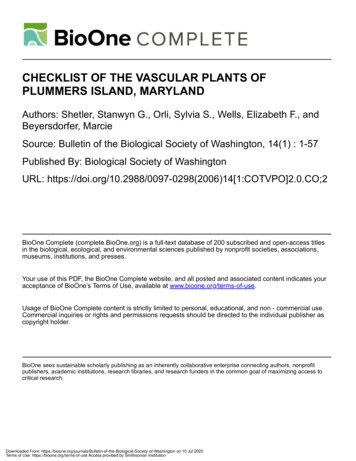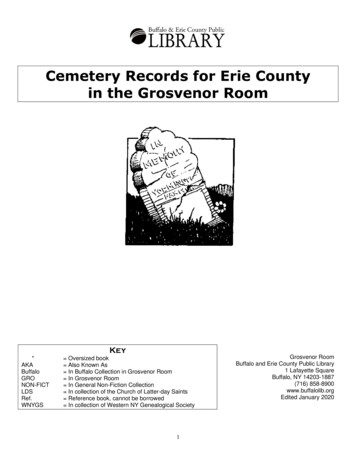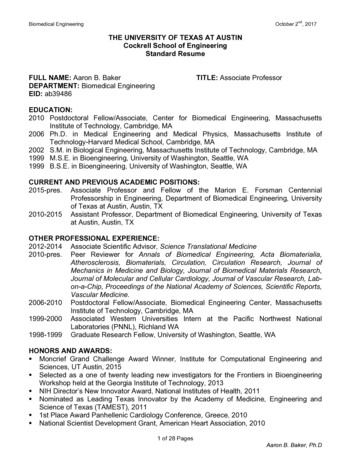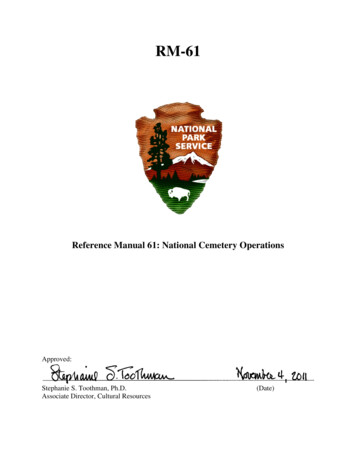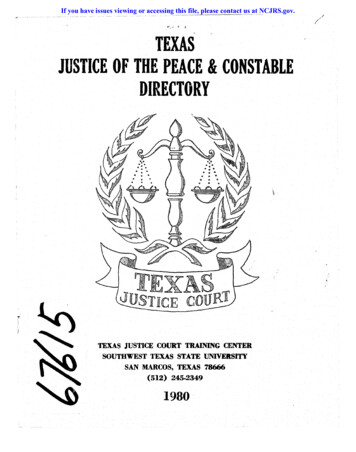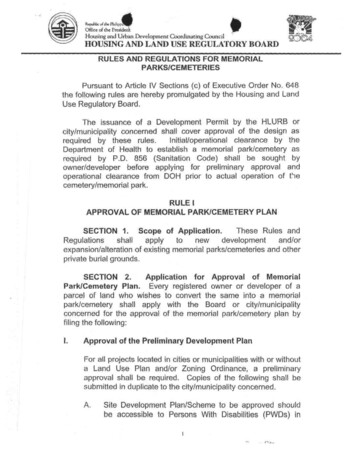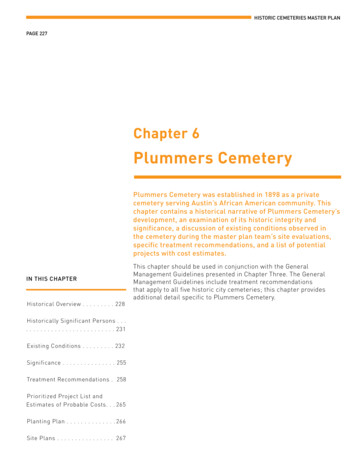
Transcription
HISTORIC CEMETERIES MASTER PLANPAGE 227Chapter 6Plummers CemeteryPlummers Cemetery was established in 1898 as a privatecemetery serving Austin’s African American community. Thischapter contains a historical narrative of Plummers Cemetery’sdevelopment, an examination of its historic integrity andsignificance, a discussion of existing conditions observed inthe cemetery during the master plan team’s site evaluations,specific treatment recommendations, and a list of potentialprojects with cost estimates.IN THIS CHAPTERHistorical Overview . . . . . . . . . 228Historically Significant Persons . . . . . . . . . . . . . . . . . . . . . . . . . . . 231Existing Conditions . . . . . . . . . 232Significance . . . . . . . . . . . . . . . 255Treatment Recommendations . 258Prioritized Project List andEstimates of Probable Costs. . . 265Planting Plan . . . . . . . . . . . . . . 266Site Plans . . . . . . . . . . . . . . . . 267This chapter should be used in conjunction with the GeneralManagement Guidelines presented in Chapter Three. The GeneralManagement Guidelines include treatment recommendationsthat apply to all five historic city cemeteries; this chapter providesadditional detail specific to Plummers Cemetery.
CITY OF AUSTINPLUMMERS CEMETERYPAGE 228HISTORICAL OVERVIEWPlummers Cemetery is a historically African American, Upper Southfolk cemetery, containing family plots, handmade markers, andexamples of art and craft. It is located at 1150 Springdale Road, onthe east side of Austin near the intersection of Springdale Road andAirport Boulevard. Nearby neighborhood associations include theEast MLK (Martin Luther King) Combined Neighborhood Association,the East Austin Conservancy, and the M.E.T.S.A. (MLK, Ed Bluestein,Tannehill, Springdale, Airport) Neighborhood Association.The development of Plummers Cemetery is largely a matter ofspeculation today, as the records available are limited; while theintensive research needed to write a complete history of the cemeterywas not within the scope of this plan, the following information shouldprovide a useful starting point for future researchers.Plummers Cemetery was likely established prior to 1898, the deathyear of Jack Jones, possibly the first person interred in the cemeterywith a marker.128 The cemetery may have been known as Mount CalvaryCemetery,129 not to be confused with another Mount Calvary Cemetery(located elsewhere in the city). The cemetery was named for ThomasP. Plummer (1860–1926), an African American Texas native who owneda farm in Travis County in 1900130 and later worked as the cemeterysexton. Thomas’ wife Mattie, who died in 1909, is buried at PlummersCemetery near the top of the hill. Thomas Plummer briefly establishedthe Capital City Burial Association, a fraternal beneficiary association,in June 1908;131 whether that organization was ever a going concernis unknown. He failed to file its annual report in 1909, and theassociation subsequently may have been dissolved.132A variety of public records from the early 1900s include referencesto Thomas Plummer as the sexton of Mount Calvary Cemetery. It ispossible that two “Mount Calvary” cemeteries were established, onefor white people and one for black people. Even during the 1920s,the cemetery was known variously as both “Mount Calvary” and“Plummer’s.” (Over time, the apostrophe was dropped.)128. City of Austin Cemetery Recordsfor Plummers Cemetery, AustinHistory Center.Plummer, who resided at 1606 Gregory Street, died on May 7, 1926at the age of 71. His death certificate gave his occupation as “gravesexton” and stated that he was buried at “Mt. Calvary Cemetery.” Hisdaughter, Annie Plummer, provided the information for the deathcertificate.130. 1900 U.S. Census records,Precinct No. 3 (Austin),Enumeration District No. 109,Sheet 14.129. Deed of sale, Travis CountyProperty Records, Vol. 354, 228–229.131. Annual Report, Texas Board ofInsurance Commissioners, Vol.33, pages 39 and 148. (Austin: VonBoeckman-Jones Co., 1908)132. “File No Annual Statement,” TheDaily Express (San Antonio, Texas),Vol. 44, No. 205, Ed. 1 Saturday,July 24, 1909.
HISTORIC CEMETERIES MASTER PLANPLUMMERS CEMETERYPAGE 229A few years earlier, in November 1923, Thomas Plummer had soldthe cemetery (with the exception of Blocks 4 and 5, as well as “thoselots in said cemetery heretofore sold to private individuals”) to oneSylvester Plummer, of Travis County, for 300. The deed conveyingthe property stated that Sylvester Plummer “is now and shall remainsexton of said cemetery and have the exclusive overseering of allinterments in said lots herein conveyed.”133Based on research conducted for this report, it appears that“Sylvester” may have been a nickname for “Thomas (Tom) Sylvester,”possibly because multiple people named “Tom Plummer” lived inAustin during the early 1900s. The deed of sale conveying PlummersCemetery to the City of Austin references Thomas Sylvester Plummer,and Ida Plummer is listed in both City Directories and Census data asliving with “Sylvester,” “Tom P. Plummer,” or “Thomas S. Plummer.”Another, possibly related, Thomas W. Plummer and his wife ArbellaWhite Plummer are buried at Plummers Cemetery, but whether or howany of the Thomas Plummers are related is unknown.No map of grave lots has been located for Plummers, and earlytwentieth century burial dates appear to be located throughoutthe site. Some family plots were clearly purchased as a unit andoccupied over time, as in the other city cemeteries, but the conditionor lack of grave markers makes the development of the cemeterydifficult to determine today. However, although burials appear to haveslowed here after the 1960s, they have continued through 2014. Acontemporary map of existing gravesites has been created by SaveAustin’s Cemeteries founder Dale Flatt and informs the treatmentplans for this cemetery.133. Deed of sale, Travis CountyProperty Records, Vol 354, Page228.
CITY OF AUSTINPLUMMERS CEMETERYPAGE 230An aerial photograph taken in 1952 (Figure 291) shows that thecemetery had three access points: one being today’s entrance,the second being located approximately 210 feet northward alongSpringdale Road, and the third being located approximately 160 feetfarther north along the road. The second driveway entrance connectedto the internal cemetery drive and may have created a second loop.The third cemetery entrance appears to have also served as a drivewayfor a house that was located close to the road and may have served asthe sexton’s residence.The severe drought of the 1950s may have contributed to the loss oftrees in the cemetery, as shown in an aerial photo from 1969 (Figure292). However, rows of trees parallel to grave sections are still visible,although a comparison of later maps indicates that many of thesetrees were removed in the 1970s.The roadways in the cemetery appear to have been paved with gravelduring the mid-twentieth century; today, they are still visible buthave become grassy paths. The wooded area around the cemetery’sperimeter has grown into what had been grassy lawn, and may nowobscure older graves and markers.Figure 291. Aerial photo of Plummers Cemetery as itappeared in 1952, with the addition of stars to indicatethe locations of the three cemetery entrances (City ofAustin)Figure 292. Aerial photo of PlummersCemetery as it appeared in 1969 (City ofAustin)
HISTORIC CEMETERIES MASTER PLANPLUMMERS CEMETERYPAGE 231The cemetery is relatively small—only about eight acres in size—andburials have taken place fairly continuously throughout the 20thcentury and into the present day.Plummers Cemetery contains a variety of handmade, craftsmancarved, machine carved, and military grave markers. Many of thehandmade markers are poured concrete with inset letters and arenotable for the content of the aggregate, which in many cases featureslarge pieces of mica, a stone with high reflectivity, mixed into orpressed into the surface of the concrete.HISTORICALLY SIGNIFICANTPERSONSPlummers Cemetery contains the graves of several hundred people,although the exact number is unknown and many graves may be, atthis late date, unmarked. In addition, the previous use of the name“Mount Calvary” for both this cemetery and another extant cemeterymakes this research difficult, as death certificates listing “MountCalvary” might refer to either cemetery. Extensive additional research,beyond the scope of this project, is needed to better identify the peoplewho are buried at Plummers Cemetery and their place in the history ofAustin and Austin’s African American Community.One significant person known to be buried in this cemetery is:Tom Sylvester Plummer (1902–1986), businessman; first black deputysheriff in Travis County, 1949–1953, 1968–1972, 1973–1976; organizer,El Dorado social club
CITY OF AUSTINPLUMMERS CEMETERYPAGE 232EXISTING CONDITIONSEcological SettingThe acid soils at Plummers Cemetery support vegetation and florathat are distinct from those on the other associations found in thearea. The typical vegetation on these soils is a mix of post oak/blackjack oak/Eastern red cedar woodlands and patches of mid- toshortgrass grasslands. At the flora level, this association is home tomany species commonly found on the sandy acid soils of eastern Texasbut seldom, if ever, found on the clayey alkaline soils in the other 97percent of Travis County. Plummers contains an abundance of cedarelm, with a few oaks and Eastern red cedar trees. There is at least oneprotected tree at Plummers—a huge American elm near the easternboundary of the site.Plummers Cemetery is partially developed and situated in an urbanarea. In the developed areas of the cemetery, where vegetation ismaintained to create a park-like setting studded by shade trees, thewoody vegetation attracts common urban wildlife species, includingmany birds and a few mammals such as squirrels, raccoons, andopossums. The undeveloped wooded area in the western part of thepark bordering the floodplain of Tannehill Branch provides cover,foraging area, and habitat for more wildlife. However, because invasiveexotic species such as Chinese privet have largely taken over theunderstory, and due to the density of vegetation in these areas, andtheir relatively limited extent, the cemetery provides marginal wildlifehabitat and is unlikely to contain suitable habitat for the listed speciestracked by TPWD in Travis County (TXNDD, 2014). Frequent mowingand other disturbances also make the maintained areas unsuitable ashabitat for protected plants.Plummers Cemetery is located in Karst Zone 4, which includes areaswhich do not contain endangered cave fauna. No City-defined CriticalEnvironmental Features (CEFs) were observed in the cemetery duringrecent surveys.
HISTORIC CEMETERIES MASTER PLANPLUMMERS CEMETERYPAGE 233TopographyPlummers Cemetery is organized along the edge of a broad ridgethat extends from the east (Figure 293). The highest point in thecemetery occurs at about the midpoint of the eastern boundary, withan elevation of 538 feet above mean sea level (AMSL). The ridge slopesgently westward, and is punctuated by two drainage channels thatflow toward Tannehill Branch to the west, dividing the site roughly intothree distinct knolls (Figure 294 on page 234). A slight rise in thesouthernmost knoll contains the looped vehicular drive. At the westernedge of the ridge, the land slopes sharply down to join the TannehillBranch floodplain. This steeply sloped area is entirely wooded and hasno known burial sites.Figure 293. Topography of Plummers Cemetery (Plummers Topo; Project Team)
CITY OF AUSTINPLUMMERS CEMETERYPAGE 234Figure 294. A drainage channel divides the cemetery (John Milner Associates)Geology and SoilsThe underlying geology of Plummers Cemetery consists ofPleistocene-age fluviatile terrace deposits (Qt), with the westernportion being Upper Cretaceous-age Ozan Formation of the NavarroGroup (Ko). Two soil types arise from these deposits, as well asimported soils: one is a combination of urban land and Travis soils(TuD), which makes up the entirety of the burial area, and the otheris a combination of urban land and Houston Black soils (HsD), whichoccurs in the woodland at the edge of the cemetery boundary (Figure295 on page 235).Of the first type, Travis soils make up about 45 percent, urban landmakes up about 35 percent, and other soils about 20 percent. Travissoils have a surface layer of gravelly fine sandy loam about 18 inchesthick, with a second layer of red gravelly sandy clay to a depth of 50inches. Urban soils are made up of a mixture of native and importedsoils and other material, and cannot be described unless specificallytested. The Travis soils and urban land in Plummers Cemetery arecharacterized by 1–8 percent slopes.
HISTORIC CEMETERIES MASTER PLANPLUMMERS CEMETERYPAGE 235The second type of soil present in a small area of Plummers Cemeteryconsists of about 56 percent Houston Black clay, 30 percent urbanland, and 14 percent other soils, including Heiden clay and Burlesonclay. Houston Black soils have a surface layer of very dark gray clayor gravelly clay about 30 inches thick, with a secondary layer of darkgray clay to a depth of 75 inches, underlain by mottled clay. The urbanland is of an unknown composition. The portion of the cemetery wherethese soils occur is entirely wooded and has no known burial sites.Figure 295. Plummers Cemetery soils (Plummers Soils; Project Team)
CITY OF AUSTINPLUMMERS CEMETERYPAGE 236Cultural Setting: Previously ConductedArcheological and HistoricalInvestigationsThe Texas Historical Commission’s Archeological Sites Atlas indicatesthat Plummers Cemetery was recorded as site number 41TV1675in 1994. (Number conventions for Texas archaeological sites are asfollows: “41” is Texas’ place in an alphabetical list of the states; “TV”is an abbreviation for Travis County; and “1675” indicates that thesite was the 1,675th recorded within Travis County at the time of itsrecording.) The cemetery was described in a 2004 cemetery data formas being maintained (although some of the gravestones were notedto have fallen over) in an urban setting. The stones are manufacturedfrom granite, limestone, and marble, and there are also metal funeralmarkers, with some graves being unmarked.In addition to the recorded site and the cemetery, a small linear surveywas conducted through the eastern portion of the grounds. This surveywas completed in 1999 for the U.S. Army Corps of Engineers - FortWorth District. No sites were documented in the vicinity as a result ofthis survey.No additional archeological sites, surveys, National Register ofHistoric Places individually listed buildings or historic districts, StateAntiquities Landmarks, or historical markers are recorded within 30meters of the cemetery boundaries.
HISTORIC CEMETERIES MASTER PLANPLUMMERS CEMETERYPAGE 237Spatial OrganizationPlummers Cemetery is located three miles east of the Austin citycenter. The approximately triangular cemetery is bounded by GivensPark to the west, East 12th Street and a small residential developmentto the north, and Springdale Road to the east (Figure 296).EaSgdprinFigure 296. Plummers Cemetery (field map by Project Team)a ledRoast 12thStreet
CITY OF AUSTINPLUMMERS CEMETERYPAGE 238Plummers Cemetery was organized in a loose grid applied over alandscape comprising three knolls. The knolls are separated fromeach other by draws that fall in a westward direction towards TannehillBranch, which runs through the adjacent Givens Park. The currententrance drive into the cemetery runs perpendicular to SpringdaleRoad and rises to the summit of the southernmost knoll. It connects toanother drive, which parallels Springdale Road and is the organizingspine of the cemetery: most of the burial plots are arranged generallyperpendicular to and along this drive, oriented approximately tothe southeast. Graves within the cemetery appear scattered and itsinternal organization is not easily legible at ground level becausemany of the graves are not marked, or their markers have beendamaged or lost. Most of the burials occur on the central knoll, whichwas historically also accessed by a second drive perpendicular toSpringdale Road. A few mid-twentieth century burials are locatedon the smallest knoll in the north corner of the site (Figure 297 andFigure 298 on page 239).
HISTORIC CEMETERIES MASTER PLANPLUMMERS CEMETERYPAGE 239Figure 297. Burials in south half of Plummers Cemetery (Plummers Cem Map – Flatt 2009.pdf)Figure 298. Burials in north half of Plummers Cemetery (Plummers Cem Map – Flatt 2009.pdf)
CITY OF AUSTINPLUMMERS CEMETERYPAGE 240Circulation and AccessAn entrance drive from Springdale Road provides the only vehicularaccess into Plummers Cemetery, entering at the approximate midpointof the cemetery’s eastern boundary. Vehicular access to the cemeteryoutside of posted times is restricted by a metal single-arm gate.Because the cemetery has no boundary fence, pedestrians can gainaccess at any time.Within the cemetery, vehicular circulation is provided via a narrowgravel and dirt drive that extends west into the site up onto thesouthern knoll before making a counterclockwise loop and crossingitself to extend north through the cemetery, parallel to SpringdaleRoad (Figure 299 on page 240).Pedestrian circulation is not defined within the site, but can occuralong the loop road and in spaces between burial plots. Formalaccess, into the few family plots defined by curbs or walls, is usuallydefined by low thresholds set into the curb or wall (Figure 300). Acity bus stop on Springdale Road required the installation of a shortsection of concrete sidewalk along a portion of the eastern edge ofthe cemetery (Figure 301). Social trails extend from both ends of thissidewalk to parallel Springdale Road along the cemetery boundary(Figure 302).Figure 299. A narrow gravel and dirt drive provides theonly vehicular circulation through the cemetery. (JohnMilner Associates)Figure 300. Access to family plot via a low stonethreshold (John Milner Associates)
HISTORIC CEMETERIES MASTER PLANPLUMMERS CEMETERYPAGE 241Figure 301. Concrete sidewalk along the east side of thecemetery on Springdale Road (John Milner Associates)Figure 302. Social trail on cemetery grounds alongSpringdale Road (John Milner Associates)
CITY OF AUSTINPLUMMERS CEMETERYPAGE 242Vegetation ManagementPlummers Cemetery contains a mix of native and naturalized treesand other plants, including self-seeded species and cultural plantings.TreesThe burial area of Plummers Cemetery is generally characterizedby an open, rolling grass lawn dominated by a mature grove ofcedar elm (Ulmus crassifolia) (Figure 303). A few other species arepresent in this grove, including post oak (Quercus stellata), chinaberry(Melia azedarach), Amerian elm (Ulmus americana), ashe juniper(Juniperus ashei), live oak (Quercus virginiana), blackjack oak (Quercusmarilandica), pecan (Carya illinoinensis), and honey mesquite (Prosopisglandulosa). Most of these trees are in fair condition and exhibit someportion of dead wood (Figure 304).Historic aerials of Plummers Cemetery indicate that, earlier in thetwentieth century, trees had been planted in rows parallel to thearrangement of burial plots (Figure 305). This pattern is no longerevident in the cemetery, due to the removal of numerous treessometime between 1967 and 1973, as seen in a comparison of historicaerial photographs on the website HistoricAerials.com.Figure 303. A grove of cedar elm dominates the cemetery.(John Milner Associates)
HISTORIC CEMETERIES MASTER PLANPLUMMERS CEMETERYPAGE 243Figure 304. Trees in Plummers Cemetery (Plummers Trees; Project Team)Figure 305. Aerial photograph of Plummers Cemetery, 1966 (Plummers 1966, City of Austin)
CITY OF AUSTINPLUMMERS CEMETERYPAGE 244In a number of instances, a mature tree is growing directly adjacent toor behind a grave marker, in line with the Upland South folk cemeterytradition of planting trees (typically Eastern red cedar) in family plotsor next to individual graves. In a few cases, the tree has causeddamage or lifting to adjacent grave markers or plot enclosures (Figure306).The western portion and southern tip of the site have thick stands ofwoodland, also dominated by cedar elm. The woodland areas havesignificant underbrush, including shrubs such as privet (Ligustrum sp.)and elbowbush (Forestiera pubescens).Figure 306. Tree roots causing damage to adjacentmarkers (John Milner Associates)Figure 307. Paired trees (McDoux Preservation)
HISTORIC CEMETERIES MASTER PLANPLUMMERS CEMETERYPAGE 245Shrubs, Vines, and BulbsPlummers is very sparsely planted with ornamental species.Throughout the cemetery, a grass lawn is kept mowed. Otherplants, including shrubs, perennials, and bulbs have been plantedas ornamentals within family plots or adjacent to grave markers.Ornamental species observed in the cemetery include Dutch iris (Irisgermanica), crinum lily (Crinum asiaticum), daffodil (Narcissus sp.), andagave (Agave sp.) (Figure 308, Figure 309). Other species also may bepresent, but were not evident during the site visit.Figure 308. Crinum lily (John Milner Associates)Figure 309. Agave (left) and iris (right) (John MilnerAssociates)
CITY OF AUSTINPLUMMERS CEMETERYPAGE 246Grave MarkersPlummers Cemetery has more than 500 documented burials, butnot all of these are marked with headstones. Those markers that arepresent vary in both size and material, with most being fairly simpleand relatively small.Plummers Cemetery was established in the early twentieth century,and burials have continued there through the present. It was anAfrican American cemetery and contains approximately 278 intermentsspread over eight acres. Many graves are unmarked. Of those thatwere marked at one time, the associated markers may have sincebeen lost or destroyed; marker fragments are visible throughout thecemetery.Marker TypesMost grave markers in Plummers Cemetery are made of eitherconcrete, granite, or marble (Figure 310, Figure 311). A few limestonemarkers are present, as are individual examples of brick, bronze,and steel markers (Figure 312). No above-ground tombs are present.Several infant graves are located in the cemetery, some identified bylamb motifs, but there is no separate infant section.Most markers feature carved, pressed, or molded inscriptions, someof which are worn and hard to read. Many are clearly handmade ofconcrete or other materials; some are embellished with inlaid tile.Many of the concrete markers appear to be made by the same personor company; these distinctive pieces feature larger pieces of micaand other decorative applied aggregate (Figure 317). A series of stonemarkers enframed in concrete are also present (Figure 318–Figure320).Adverse ConditionsGrave markers at Plummers Cemetery are adversely affected bysoiling and biological growth, differential settling due to soil orfoundation conditions, mower/trimmer damage, and cracking (Figure321–Figure 326). Several markers exhibit visible repairs (Figure 327–Figure 329 on page 251). Approximately 25–30 percent of markers areslightly or severely tilted from settling or foundation conditions.Nearly all of the remaining grave markers in Plummers Cemeteryare in need of conservation and repair. The extent of damage in thiscemetery is far greater, for its size, than in the other four municipallyowned cemeteries. The number and variety of handmade markers issignificant and should be addressed by an art conservator.
HISTORIC CEMETERIES MASTER PLANPLUMMERS CEMETERYPAGE 247Figure 311. Granite markers with ceramic photographs(McDoux Preservation)Figure 310. A fallen marble marker (McDouxPreservation)Figure 312. Welded metal cross (John MilnerAssociates)
CITY OF AUSTINPLUMMERS CEMETERYPAGE 248Figure 313. Handmade concrete marker (McDouxPreservation)Figure 315. Handmade marker with tile embellishment(McDoux Preservation)Figure 317. Concrete grave marker with distinctive micaaggregate (McDoux Preservation)Figure 314. Handmade stone marker (McDouxPreservation)Figure 316. Handmade marker with tile embellishment(McDoux Preservation)Figure 318. Stone marker enframed in concrete(McDoux Preservation)
HISTORIC CEMETERIES MASTER PLANPLUMMERS CEMETERYPAGE 249Figure 319. Stone marker in concrete (McDouxPreservation)Figure 321. Mower damage (McDoux Preservation)Figure 320. Stone marker in concrete; the marker issunken and shows mower damage (McDoux Preservation)Figure 322. Broken concrete cross (McDouxPreservation)
CITY OF AUSTINPLUMMERS CEMETERYPAGE 250Figure 323. Biological growth (McDoux Preservation)Figure 324. Biological growth (McDoux Preservation)Figure 325. Marker displaced by contact with a mowerand severely damaged by trimmers (McDoux Preservation)Preservation)Figure 326. Mower damage to a flush marker (McDoux
HISTORIC CEMETERIES MASTER PLANPLUMMERS CEMETERYPAGE 251Figure 327. Repaired cracks (McDoux Preservation)Figure 329. Cracked marker (John Milner Associates)Figure 328. Cracked marker with visible repairs(McDoux Preservation)
CITY OF AUSTINPLUMMERS CEMETERYPAGE 252Plot CoveringsMost burial sites in Plummers Cemetery feature a covering of mowedgrass; however, in a few instances, plots have been covered withpoured concrete slabs (Figure 330). These range in appearance fromsimple concrete pads set flush with the ground, to more ornamentalcoverings. A row of burial sites in the north part of the cemetery ispaved with rounded concrete units outlined in brick (Figure 331). Thisfeature is in fair condition, with some cracking of the concrete, and theloss and displacement of some bricks.Plot EnclosuresOnly a handful of family plots in Plummers are bounded by curbsmarking their extents. Curb materials vary, ranging from simplepoured concrete to low mortared brick or limestone walls (Figure 332).The curbs are often punctuated by upright stones on either side of alow stone or concrete threshold, marking the formal plot entrances(see Figure 300 on page 240). In addition to the family plot enclosures,there are also a few instances of enclosures around individual graves(Figure 334).Most of the plot and grave enclosures are in poor condition, withbroken, displaced, or missing material, and damage from treeroots (Figure 333). Other problems include subsidence damage andmaintenance problems such as damage from mowers and stringtrimmers.Plot FencingNone of the burial plot enclosures in this cemetery feature fencing.Figure 330. Family plot covered with a poured concreteslab (McDoux Preservation)Figure 331. Family plot covered with concrete andoutlined in brick (McDoux Preservation)
HISTORIC CEMETERIES MASTER PLANPLUMMERS CEMETERYPAGE 253Figure 332. Family plot enclosures (John Milner Associates)Figure 334. The curb surrounding this individual burialis slightly sunken at one corner [John Milner Associates]Figure 333. A severely damaged plot enclosure (JohnMilner Associates)
CITY OF AUSTINPLUMMERS CEMETERYPAGE 254Water FeaturesPlummers does not feature any irrigation systems. The only waterfeature on site is a concrete storm water culvert that drains waterfrom Springdale Road, funneling water into the drainage channel inthe northern part of the cemetery.StructuresFence SystemUnlike the other four historic Austin cemeteries, Plummers Cemeterydoes not have an enclosing boundary fence. Access to the cemeteryloop drive from Springdale Road is restricted by means of a simplemetal swing gate (Figure 335).Small-Scale FeaturesSigns & Site FurnishingsNo site furnishings are provided for visitor use within Plummers. Signsat the entrance to the cemetery include a large cemetery identificationsign and informational signs citing cemetery rules and regulations(Figure 336). A few city signs, including a sign denoting the bus stop,have been installed along the edge of the cemetery on SpringdaleRoad. Other city features along Springdale Road include manholes andpoles for overhead electrical and telephone lines.Grave FurnishingsVery few burial sites feature the types of grave decorations prevalentin the other historic cemeteries; the extent of decorative features atPlummers is limited to a few graves set with silk flowers.Figure 335. A metal gate controls access to thecemetery. (John Milner Associates)Figure 336. Signs clustered at the cemetery entrance(John Milner Associates)
HISTORIC CEMETERIES MASTER PLANPLUMMERS CEMETERYPAGE 255SIGNIFICANCEIn order to develop treatment recommendations that are wellgrounded in national standards, this master plan proposes areasand periods of significance, evaluates the cemetery under NationalRegister Criteria, and determines its integrity.In order to determine potential strategies for listing PlummersCemetery in the National Register, the author reviewed a sample ofNational Register listings for African American cemeteries in otherstates. Most of these examples seem to be more similar to PlummersCemetery than to Evergreen Cemetery (see Chapter 7), in terms ofage, history, resources, and plan.Golden Hill Cemetery in Clarksville, Tennessee, is one examplethat may provide a model for nominating Plummers Cemetery. LikePlummers Cemetery, Golden Hill is relatively small (just undereight acres) and was established by an individual. It was listed as anHistoric Landmark (site) on the basis of Criteria A and C, with CriteriaConsideration D, in the areas of ethnic heritage, art, and settlementpatterns. The bibliography in the Golden Hill nomination also mayprovide assistance to future researchers.Criterion A: Properties can be eligible for the National Register if theyare associated with events that have made a significant contribution to thebroad patterns of our history.Plummers Cemetery may be significant as a representative examplewithin the context of Texas rural folk cemeteries. Additional researchwould be required to develop the context and place this cemeterywithin it.Criterion C: Properties may be eligible for the National R
Plummers Cemetery Plummers Cemetery was established in 1898 as a private cemetery serving Austin's African American community. This chapter contains a historical narrative of Plummers Cemetery's development, an examination of its historic integrity and significance, a discussion of existing conditions observed in


